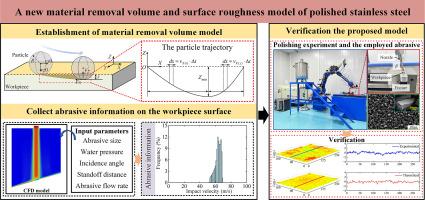新型抛光不锈钢材料去除率及粗糙度模型
IF 9.4
1区 工程技术
Q1 ENGINEERING, MECHANICAL
International Journal of Mechanical Sciences
Pub Date : 2025-09-17
DOI:10.1016/j.ijmecsci.2025.110844
引用次数: 0
摘要
预混合磨料水射流(PAWJ)技术在表面加工和抛光中得到了广泛应用。然而,PAWJ中传统的不锈钢材料去除率和粗糙度模型是经验或半经验的,误差较大,缺乏符合实际加工条件的理论模型。因此,考虑到弹性加载、弹性卸载和塑性加载阶段对冲击力学的影响,本文建立了一种新的材料去除体积和粗糙度模型。运用动力学理论和赫兹接触力学分析了单颗粒的冲击行为,建立了有效磨粒形成的条件。采用计算流体动力学(CFD)仿真,获取不同工艺参数下颗粒碰撞的详细信息,用于识别有效磨粒,并作为模型的初始输入。通过一系列抛光实验验证了所提模型的正确性,并结合CFD仿真结果分析了工艺参数对表面微观结构的影响。理论表面粗糙度与实验结果吻合较好,最大相对误差为17.49%。误差来源于两个方面:一是假设标准球形颗粒,由于实际角颗粒的接触面积较小,低估了撞击深度和粗糙度;PAWJ后加工痕迹周围有残余材料积累,与建模中材料完全去除的假设相反,导致实验结果大于理论结果。本文为深入了解PAWJ的微尺度材料去除提供了理论基础,为工艺优化提供了理论依据。本文章由计算机程序翻译,如有差异,请以英文原文为准。

New material removal volume and roughness model of polished stainless-steel
Pre-mixed abrasive water jet (PAWJ) technology has been widely applied in surface machining and polishing. However, the traditional material removal volume and roughness model for stainless steel in PAWJ is empirical or semi-empirical with a significant error, and there is a lack of a theoretical model that conforms to actual processing conditions. Therefore, this paper develops a novel model for material removal volume and roughness, considering the effects of the elastic loading, elastic unloading, and plastic loading stages on the impact mechanics. The impact behavior of a single particle is analyzed using kinetic theory and Hertzian contact mechanics, and the condition for effective abrasive particles is established. Computational Fluid Dynamics (CFD) simulation is employed to obtain detailed information on particle impact at different process parameters, which is used to identify effective abrasive particles and serve as initial input for the model. The proposed model is verified through a series of polishing experiments, and the influence of process parameters on surface microstructures is analyzed by integrating CFD simulation results. Theoretical surface roughness agrees well with experimental results, with a maximum relative error of 17.49%. The error stems from two sources: the assumption of standard spherical particles, which underestimates impact depth and roughness due to the smaller contact area of actual angular particles; and residual material accumulates around the machining marks following PAWJ, in contrast to the assumption of complete material removal in modeling, leading to larger experimental results than theoretical ones. This paper provides an in-depth understanding of micro-scale material removal in PAWJ and a theoretical foundation for process optimization.
求助全文
通过发布文献求助,成功后即可免费获取论文全文。
去求助
来源期刊

International Journal of Mechanical Sciences
工程技术-工程:机械
CiteScore
12.80
自引率
17.80%
发文量
769
审稿时长
19 days
期刊介绍:
The International Journal of Mechanical Sciences (IJMS) serves as a global platform for the publication and dissemination of original research that contributes to a deeper scientific understanding of the fundamental disciplines within mechanical, civil, and material engineering.
The primary focus of IJMS is to showcase innovative and ground-breaking work that utilizes analytical and computational modeling techniques, such as Finite Element Method (FEM), Boundary Element Method (BEM), and mesh-free methods, among others. These modeling methods are applied to diverse fields including rigid-body mechanics (e.g., dynamics, vibration, stability), structural mechanics, metal forming, advanced materials (e.g., metals, composites, cellular, smart) behavior and applications, impact mechanics, strain localization, and other nonlinear effects (e.g., large deflections, plasticity, fracture).
Additionally, IJMS covers the realms of fluid mechanics (both external and internal flows), tribology, thermodynamics, and materials processing. These subjects collectively form the core of the journal's content.
In summary, IJMS provides a prestigious platform for researchers to present their original contributions, shedding light on analytical and computational modeling methods in various areas of mechanical engineering, as well as exploring the behavior and application of advanced materials, fluid mechanics, thermodynamics, and materials processing.
 求助内容:
求助内容: 应助结果提醒方式:
应助结果提醒方式:


